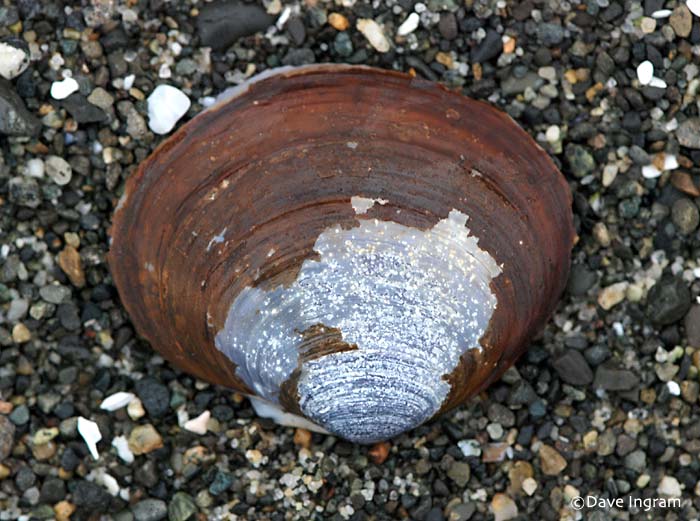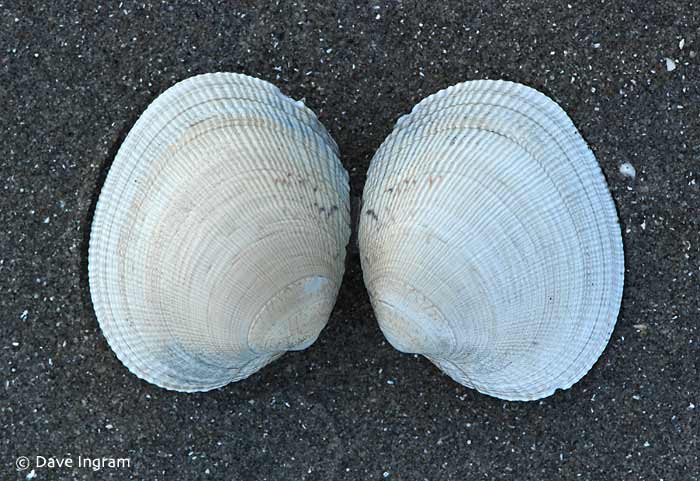One of the joys of walking the beaches of Vancouver Island is finding a clam shell or two while out on the sand or cobble. For those new to West Coast beach combing, determining the species of bivalve that the shell belongs to can be challenging. Rick M. Harbo’s Shells and Shellfish of the Pacific Northwest provides a good starting point to identifying clams and snails that can be found along the coasts of Vancouver Island. Of the 180 species of clams described in British Columbia, Harbo’s book includes 100 of the more common species.
Clam shells play an important role in the beach ecosytem. Organisms like shore crabs, hermit crabs, limpets, and isopods often use them as shelter. Barnacles will attach themselves to clam shells as well. While you may think that taking just one shell won’t make a difference consider that you are one visitor among many. Shells break down and their calcium recycles back into the ecosystem. Other organisms use the calcium when it returns to the environment. The larger fragments of shell break down and become part of the sand.
With a little work exploring the sandy/gravel/cobblestone beaches of the east side of Vancouver Island you’re likely to find a number of different bivalves. I’ve described four that are relatively easy to find and identify below.
Varnish Clams (Nuttallia obscurata)

This introduced clam is extremely easy to identify and fairly common. The inside of the shell is a rich royal purple. A brown varnish-like skin covers the outside of the shell. The common name of the clam is related to this characteristic. The clam grows up to 7 cm in length. Varnish Clams were introduced to British Columbia in the late 1980s to the early 1990s. Most likely the larvae arrived in the ballast of ships from Korea and Japan. Read more about the Varnish Clam.

Japanese Littleneck Clam (Venerupis phillippinarum)

The Japanese Littleneck Clam is also an introduced species, and arrived in larval form with Japanese Oyster spat in the early 1900s. It is fairly easy to identify. However, be careful not to confuse it with the native Pacific Littleneck (see description of this species below). The diagnostic field marks for the Japanese Littleneck are the purple staining at the posterior margin of the inner shell, its oblong shape, and the mountain-like patterns on the surface of the shell. This clam grows to 7.5 cm in length. Read more about the Japanese Littleneck.

Pacific Littleneck (Protothaca staminea)

The Pacific Littleneck looks similar to the Japanese Littleneck but its shell is rounder in shape. Mature specimens lack the mountain-like patterns on the surface of the shells. Note that immature Pacific Littleneck shells often have patterns as well. Shells of this species of clam can be up to 7.5 cm in length. The most visible difference is the lack of purple staining inside the shell but consider that this purple stain might be absent or very faint on older, worn Japanese Littlenecks. If you run a finger along the margin of the shell you feel fine teeth. The Japanese Littleneck lacks these teeth. Read more about the native Pacific Littleneck.

Butter Clams (Saxidomus gigantea)

Butter Clams have thick, heavy shells that can be up to 15 cm in length. The valves are typically oval to squarish in shape and white to gray in colour. The interior of the shell is also whitish (not glossy) and marked with large muscle scars. The series of interlocking teeth at the hinge is an interesting characteristic of this species of clam. It can be used to separate it from other similar looking large, white shelled clams. Read more about the Butter Clam.
These are just four of the many types of clam shells that can be found on the beaches of Vancouver Island. Look for them on your next walk on the beach, pick them up and impress your friends with your ability to identify them! Then return them to the sand for others to enjoy.

